

It has been found that we retain audience interest best when our story is concerned with murder. Therefore, although other crimes may be introduced, somebody must be murdered, preferably early, with the threat of more violence to come.
The History of Broadcasting, 1949 edition, on how to make a hit television show
Violence is central to the media's attention. Unless things get smashed, nobody pays attention.
"James," demonstrator at the G8 summit in Genoa, quoted in the LA Times, 7/22/01
A correspondent and I continue a debate begun over a violent comic book....
>> I didn't buy the book, read it & then go out & throw someone off my roof. <<
Read the comments by "Justin," the rabid Punisher fan. He sounds a little close to the edge to me. Are you prepared to vouch for his behavior? If the PUNISHER comic encourages him to do something violent, it doesn't matter what you do. "Justin" becomes a statistic supporting my case.
In other words, so what if you don't become violent? I'm concerned about more than just PUNISHER's effects on you. Can you guarantee it won't effect any of the hundreds of thousands of people who pick up a copy of the comic over the next several decades? I don't think so.
Studies show media violence's harm
Here's more from David Grossman, the expert I cited. Note his discussion of the delayed effect. Though he limited it to three-year-olds, I suspect it has much wider implications. How many people fly off the handle because they learned to respond aggressively years ago?
The Journal of the American Medical Association published the definitive epidemiological study on the impact of TV violence. The research demonstrated what happened in numerous nations after television made its appearance as compared to nations and regions without TV. The two nations or regions being compared are demographically and ethnically identical; only one variable is different: the presence of television. In every nation, region, or city with television, there is an immediate explosion of violence on the playground, and within 15 years there is a doubling of the murder rate. Why 15 years? That is how long it takes for the brutalization of a three- to five-year-old to reach the "prime crime age." That is how long it takes for you to reap what you have sown when you brutalize and desensitize a three-year-old.
Today the data linking violence in the media to violence in society are superior to those linking cancer and tobacco. Hundreds of sound scientific studies demonstrate the social impact of brutalization by the media. The Journal of the American Medical Association concluded that "the introduction of television in the 1950's caused a subsequent doubling of the homicide rate, i.e., long-term childhood exposure to television is a causal factor behind approximately one half of the homicides committed in the United States, or approximately 10,000 homicides annually." The article went on to say that ". . . if, hypothetically, television technology had never been developed, there would today be 10,000 fewer homicides each year in the United States, 70,000 fewer rapes, and 700,000 fewer injurious assaults" (June 10, 1992).
From "Children and Television Violence" by PageWise, Inc.:
In 1994, Surgeon General Jocelyn Elders said "By portraying violence as the normal means of conflict resolution, the media gives youth the message that violence is socially acceptable and the best way to solve problems. After 10 years of research, we know that a correlation exists between violence on television and aggressive behavior in children." (Goodwin, 47-48) Research results in two different studies strengthen Elders' statement. One study shows that "two years after television was introduced to the remote city of Notel, Canada, physical aggression in children in the area increased 160 percent" (Goodwin, 48) Once televison arrived in South Africa, the homicide rates among whites, which had been in the decline, increased 130 percent in twelve years. (Goodwin, 49) There may have been other factors which contributed to the increase in violence, but, these studies show that television does have an impact on youth behavior.
There have been other studies which also demonstrate the effects of violence on youth. For example, a study by AACAP found that as a result of TV violence, children may: become immune to the horror of violence; gradually accept violence as a way to solve problems; imitate violence they observe on television; and identify with certain characters, victims, or victimizers. (American, 1) As a member of The Children's Broadcast Institute, Toronto child psychiatrist Dr. Arlette Lefebrve was actively crusading against the Teenage Mutant Ninja Turtles (a show which was eventually taken off the air; but not necessarily due to violent content). She found following examples of the impact the show had on younger viewers: "A six-year-old boy wearing a turtle costume stabbed a friend in the arm for not returning a borrowed toy; A three-year-old boy picked up the family cat and swung it around his head like a Turtle hero wielding a weapon. When his mother tried to intervene, the boy said "It's just like Michelangelo". (Miller, 59-60)
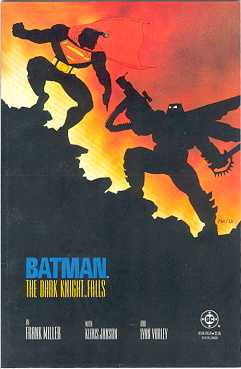
In addition, "Aletha Huston-Stein and her colleagues assessed the effects of viewing violent or pro-social (nonviolent) television programming. In this study, about one hundred preschool aged children enrolled in a special nursery school at Pennsylvania State University were divided into three groups and were assigned to watch a particular diet of programming. The children watched either a diet of Batman and Superman cartoons, a diet of Mister Roger's Neighborhood, or a diet of neutral programming (programs designed for preschoolers that contained neither violence or pro-social messages). Huston-Stein and her colleagues observed the youngsters on the playground and in the classroom for two weeks to assess the level of aggressive and helpful behavior displayed by these children. Then, the children viewed the program diet one half hour a day, three days a week, for four weeks. They watched 12 half hour episodes of the diet to which they were assigned. Researchers found that the youngsters who watched Batman and Superman cartoons were more physically active, both in the classroom and on the playground. Also, they were more likely to get into fights and scrapes with each other, play roughly with toys, break toys, snatch toys from others, and get into little altercations. No mass murders broke out, but, they were simply more aggressive and had more aggressive encounters. The other group, the group that had watched Mister Rogers' Neighborhood, was much more likely to play cooperatively with their toys, spontaneously offer to help the teacher, and engage in what might be called "positive peer counseling." ...In this instance, the focus of the Mister Rogers' sessions was similar to " peer counseling"—being kind, being sensitive to others needs, and being concerned about others feelings. For example, Fred Rogers might suggest that if someone looks sad, you could say, "Gee, you look sad today, are you feeling okay? Do you want to go play or do something" The group that watched the neutral programming was neither more aggressive nor more helpful. However, what is more interesting about this study is that it shows both sides of the coin: What children watch does affect how they behave both positively and negatively." (Murray, 4)
From the LA Times, 3/11/03:
EDITORIAL
Kid See, Adult Do
Newly released research on TV violence and its lasting effects on viewers suggests courting couples might want to inquire about their prospective spouse's childhood program proclivities. Those people—men and women—who watched the most violent TV shows as youngsters turned out to be the most violence-prone, even 15 years later, according to the University of Michigan study.
This study, unusual in that it followed people for many years, confirms what any playground monitor has long suspected: Children ape what they see. The more they see it, the more they ape it, be it Mr. Rogers or Dirty Harry. Human societies, being human, do contain inherent hypocrisies—sinning preachers, unfaithful marriage vow-takers, movie directors professing peace while promoting gory tales, parents rudely criticizing children for rudeness. Judging by TV ratings and box office sales, entertainment audiences also contain many who don't always patronize what they say they prefer.
Most disturbing is the study's evidence that viewing violence as entertainment at an impressionable young age inseminates an acceptance of or proclivity toward violence years later. And those kids were watching "Starsky and Hutch" and "The Six Million Dollar Man"! Just imagine the later effects of today's violent special effects.
Sesame Street producers quickly realized young viewers absorb more if adults watch with them, endorsing and discussing the lessons. This suggests that parents might mute the impact of ubiquitous violent fare by conscientious discussions about their values, violence and its rarely depicted consequences.
Humorist Steve Allen formed the Parents Television Council to stop TV from "leading children down a moral sewer." In a full-page ad published 5/6/00, he listed a small sampling of the consequences of TV sex and violence:
And more:
Grossman: "Violent video imagery exercises that which makes us animal."
Stanford study demonstrates marked decrease in verbal and physical aggression by turning off TVs and video games.
"The number of torture scenes on the networks last season grew at a rate almost double the previous two seasons."
Curse or Coincidence? The Catalogue of 'Scream' Killings
French Link Murders to Cult Film: 'Scream' blamed for outbreak of teenage violence
Grossman: "We have raised a generation of barbarians who have learned to associate violence with pleasure."
"[V]iolence and crime dominate media reports, creating unwarranted fear and reinforcing inaccurate images."
"The frequency of viewing wrestling on TV [is] positively associated with date fighting and other health risk behaviors."
Billy Jack: "Next to parents, films are the most powerful influence in shaping an individual's life."
Video games teach that "violence is fun, obligatory, easily justified, and essentially without negative consequences."
Study: Ordinary '80s kids are "as uptight as children who were psychiatric patients in the 1950s."
"Extraordinary consensus" about media violence
According to the LA Times, 7/29/00:
A September 1999 study released by the Center for Media and Public Affairs that surveyed broadcast television, cable stations, music videos and films drew upon research from the National Institutes of Health, the American Psychiatric Assn. and the American Medical Assn. The report's authors wrote: "Media violence not only increases aggression among young viewers, it breeds a callousness toward violence directed at others."
Psychology professor Jonathan Freedman claims the results of his study "do not support the hypothesis that exposure to media violence causes aggression or criminal behaviour in people." Another professor responded to a column about Freedman by Brian Lowry. From the LA Times, 10/6/00:

Freedman finds no evidence to indicate media violence causes aggression "after analyzing every study on media violence published in English." Sounds impressive. What Lowry doesn't explain is that this same task has been engaged by others who have reached radically different conclusions. Who else? Just the following agencies: the U.S. Surgeon General, the National Institutes of Mental Health, the National Centers for Disease Control and Prevention, the National Academy of Sciences, the American Psychological Assn., the American Medical Assn., the American Academy of Pediatrics, and the list goes on.
Every single one of these governmental, scientific and public health organizations has enlisted the nation's top experts in their field. Like Freedman, these experts have reviewed all the existing knowledge produced by empirical research over the years. And they have all come to a different conclusion than Freedman. Typical of the statements from the nation's top scientists, the American Psychological Assn.'s report on media violence concludes: "There is absolutely no doubt that those who are heavy viewers of violence demonstrate increased acceptance of aggressive attitudes and increased aggressive behavior." Does that sound like an equivocal position?
Those who fear censorship of violent content find any criticism of media violence research a convenient device to aid in their battle. What is lost in the shuffle is that most media effects researchers, myself included, do not support governmental censorship of media violence, even in the face of the overwhelming evidence of its harms.
The prevailing view in the scientific community is to encourage greater sensitivity to the issue by producers, and to provide tools to parents to help them identify the content that poses a risk of harm for their children. What troubles social scientists, however, is when those who oppose censorship of media violence attack the veracity of the evidence that violent depictions have any harmful effects.
Contrarian viewpoints like Freedman's make for good press but bad science. In the debate about media violence, the public deserves accurate and balanced information. There is no controversy within the scientific community about the effects of media violence. Rather, there is extraordinary consensus that viewing media violence poses a risk of harm to children.
Just as not every person who smokes contracts cancer, not every child who views violence behaves aggressively. Each of these elements is a risk factor, and statistical probabilities show us that children who view a lot of violence are more prone to physical aggression than those who don't. That's what we know, not just what we think.
Or as Bushman and Anderson put it in Media Violence and the American Public: Scientific Facts Versus Media Misinformation (American Psychologist, June/July 2001):
Over the last 50 years, the average news report has changed from claims of a weak link to a moderate link and then back to a weak link. However, since 1975 the scientific confidence and statistical magnitude of this link has been clearly positive and has consistently increased over time. Reasons for this discontinuity between news reports and the actual state of scientific knowledge include the vested interests of the news; a misapplied fairness doctrine in news reporting; and failure of the research community to effectively argue the scientific case.
Pushing high-risk kids over the edge
According to the LA Times, 9/18/00:
Instead, the contention is that exposure to media violence could push especially high-risk children over the edge.
The studies point to a spectrum of effects. Nightmares. Fear. A warped perception of the world as more dangerous than it truly is. Lack of empathy. Greater apathy about violence in society. And brains more primed to be hostile, aggressive, even violent, raising the risk that a hostile encounter will escalate.
Studies on the effects of violent video games or music are few, but TV and movie violence research stretches back decades. Two classic experiments in the 1960s set the ball rolling.
In one, Stanford University psychologist Albert Bandura and colleagues showed nursery school children television clips of adults abusing a toy clown called a Bobo doll. Then they watched how the children played in a room with the doll and other "nonaggressive" toys.
Kids who'd seen the aggressive videos were much more likely to kick and beat the clown, especially if they'd seen the adult being rewarded for the behavior. They did so even if the abuser had been dressed as a cartoon-like cat.
A 1963 magazine article about the experiment, complete with pictures of kids assaulting Bobo dolls with evident glee, "really shocked people—it started a national debate," says John P. Murray, professor of developmental psychology in the School of Family Studies and Human Services at Kansas State University in Manhattan, Kan.
Second Experiment at College Level
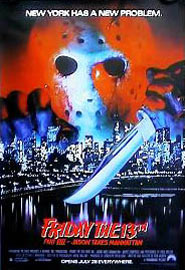
The same year, an experiment with college students also showed that violent images can heighten aggression. Students who had watched a movie clip of a brutal beating reacted with extra hostility when an assistant later insulted them.
Since that time, scientists have done many short-term experiments on children and young people using various settings and measures of aggression. Sometimes, aggression is rated through watching kids play, other times via special aggression and hostility questionnaires.
Sometimes, participants get to "punish" others by setting the intensity of so-called aggression machines, which administer (or so the participants are told) nasty zaps of electricity or blasts of white noise.
The combination of those laboratory studies with other research on the actual viewing habits of young people leads researchers to say the evidence for a damaging effect is strong—and that the influence is growing.
"Media violence is a tremendous problem," says Joanne Cantor, professor emeritus at the University of Wisconsin, Madison, and a specialist in the effects of mass media on children. "It is so pervasive. Kids are spending so many hours watching TV or movies, or playing video games, and it's having a strong effect on their attitude toward violence and their level of fear."
To counter the influence, say researchers, the entertainment industry should restrain itself and parents should exert more control over the games, movies and programs their kids are exposed to. They should discuss material with their kids "and say, 'Look—this isn't real. In real life there are consequences if you hit each other—blood, death, hurting,' " says Dorothy Singer, co-director of the Yale University Family Television Research and Consultation Center in New Haven, Conn.
News—especially graphically violent TV news—is also part of the problem, researchers say.
Some researchers are especially worried about violent video games. "As a video player, you become the violent character who's going around blowing everybody up," says Craig A. Anderson, professor and chair of psychology at Iowa State University in Ames. This is important, he says, since studies show kids are more likely to learn that aggression is OK if they identify with the aggressor.
Of course, there's a big difference between short-term experiments measuring toy clown-bashing and the criminal violence that most worries society. In various other studies, young people's viewing habits—what they watch and how much—has been measured against what kind of trouble they get into: from minor altercations to serious violent acts including murder.
Many of those studies, too, show a significant relationship between violent viewing and aggressive acts, says George Comstock, Newhouse professor at the School of Public Communications at Syracuse University, who has co-authored a large analysis of several hundred media violence studies.
Classics Focus on Emotions, Not Killings
Still, it's not as if all media violence is alike, says Seymour Feshbach, professor of psychology at UCLA and former president of the International Society for Research on Aggression. Realistic depictions—especially when paired with sex and devoid of reflection and thoughtfulness on the part of the characters—are the worst, he says.
"We don't worry about 'Hamlet' or 'Macbeth,' even though a lot of people get killed, because the plays focus not on the killings but on the feelings, motives, conflict and guilt of the characters," he says.
And from Bushman and Anderson in Media Violence and the American Public: Scientific Facts Versus Media Misinformation:
When an ad is shown on TV, no one expects that it will sell the product to everybody. If the ad influences only 1% of viewers, it is considered to be a great success (Medved, 1995). Suppose violent media make only 1% of the population more aggressive. Should society be concerned about a percentage so small? The answer is a resounding "Yes!" Suppose 10 million people watch a violent TV program. If only 1% of the viewers will become more aggressive afterward, then the violent TV program will make 100,000 people more aggressive! Because so many people are exposed to violent media, the effect on society can be immense even if only a small percentage of viewers are affected by them. It takes only one or two affected students to wreak murderous havoc in a school.
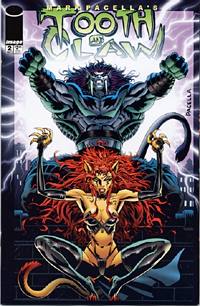 Violence apologists are in denial
Violence apologists are in denial
From Bushman and Anderson in Media Violence and the American Public: Scientific Facts Versus Media Misinformation:
One common industry response to the conclusions of such literature reviews is to deny the findings. For example, Jim Burke of Rysher Entertainment said, "I don't think there is any correlation between violence on TV and violence in society" (Stem, 1995, p. 28). Another is to claim that the effects of media violence on aggression are so small or that they effect so few people that the risks to society are negligible and can and should be ignored. For example, a Time magazine writer concluded, "While the bulk of published research has indeed found some correlation between watching fictitious violence and behaving aggressively, the correlation is statistically quite modest" (K. Anderson, 1993, p. 66).
Actually, as Bushman and Anderson show, the correlation is statistically quite strong for one of several social factors:
Earlier meta-analytic reviews of studies of media violence on aggression have reported average effect sizes ranging from r+ = .11 (Hogben, 1998) to r+ = .31 (Paik and Comstock, 1994). In all cases, the reviews found a significant positive correlation. That is, greater exposure to media violence is strongly linked to increases in aggression.
The highest estimate is almost as high as the correlation between smoking and lung cancer. The lowest estimate is about as high as the correlation between calcium intake and bone mass. We accept these linkages as proven, so why do we deny the linkage between media violence and aggression, since researchers have proved it by the same statistical techniques?
To reiterate, media violence may be almost one-third of the factors linked to aggression. If any other social problem had a factor with a 31%—or "only" an 11%—correlation, we'd say, "Wow, that's a big factor." Only in this case do we retreat to our comfort zones and deny the demonstrable linkage.
More commentaries on our state of denial. From the LA Times, 10/1/00:
The idea that watching gratuitous violence and sex has no effect on a child is so preposterous that anyone who believes this only testifies to the human ability to deceive oneself. If companies believed this, all advertising would end, and with it television itself. Children watching murders doesn't cause them to murder. But is that now our parental and societal standard for what we should feed our children's souls—asking whether it causes them to murder? Are there no other adverse effects? Of course there are.
Dennis Prager, author and lecturer
And from the LA Times, 10/22/00:
Previously unimaginable computer-generated visual effects and tremendous strides in audio engineering have created images more visceral in their one-two punch; nothing man has previously created has had this kind of impact on our biochemical sensory pathways. The argument that today's film fare is no more crude or brutal than popular entertainment across the ages, from medieval Punch and Judy shows to 19th century Gothic melodrama, is disingenuous at best.
Dale Pollock, film critic, film producer, and film school dean
And more:
TV writer/producer: "The people creating mass entertainment are involved, are a part of it and are culpable."
Moby: "You can't put out homophobic and misogynist and racist stuff and say it's all a joke."
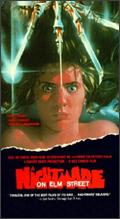
Ten major health organizations speak out
From the LA Times, 12/13/00:
Media: Study sees TV shows, films as contributing factors. Caregivers urge other ways to depict anger, conflict.
By MARLENE CIMONS, Times Staff Writer
WASHINGTON—The entertainment industry took another hit Tuesday—this time from a group of health care professionals who concluded in a study that television shows, movies, music, video games and the Internet are contributing to youth violence in America.
Ten major health organizations, including the American Medical Assn., urged Hollywood in a news conference Tuesday to curb the aggression it showcases and find nonviolent ways to depict the resolution of anger and conflict.
The coalition of health professionals, which also blamed school violence on the easy access children have to guns and on society's inadequate support of families, urged the public to rally against teen violence "much as we have moved against smoking, drunken driving and failure to use seat belts."
.
.
.
While statistics show that the incidence of youth violence is not increasing, the United States still has the highest youth homicide and
suicide rates among the 26 wealthiest nations, according to the American Academy of Family Physicians, one of the groups involved in the study.
Almost 16 million American teens have witnessed some form of violent assault, including robbery, stabbing, shooting, murder or domestic abuse, and about 1 in 8 people murdered annually in this country is younger than 18, the academy said.
Furthermore, well-publicized school-based shootings—such as the April 20, 1999, killings at Columbine High School in Littleton, Colo.—have focused increasing public attention on the issue of children and violence. In that tragedy, two students opened fire in the school, killing 12 students, one teacher and themselves.
The report called on parents to "monitor and control" use of the media by their children and urged the industry not only to reduce violent content but also to strive to depict situations where nonviolent methods successfully resolve conflict and anger.
Also, it recommended that industry "depict accurately the pain, remorse and other consequences of violence and violent behavior on individuals, families and society."
.
.
.
The commission also called for new public policy initiatives to help struggling families meet basic needs, such as housing, food, child care and health care.
The commission was made up of nine groups and the Department of Health and Human Services. HHS is also sponsoring its own report on youth violence. It is being compiled by the U.S. surgeon general and is expected soon.
In addition to the AMA, the pediatric and family physician academies, the other groups participating in the study are the American Public Health Assn., the American Nurses Assn., the American Psychiatric Assn., the American College of Physicians, the American Academy of Child and Adolescent Psychiatry and the American Medical Assn. Alliance.

Media triggers teenage killers
From an interview with Jamie Rouse after he killed a teacher and a student at his school in Lynnville, Tenn. In the LA Times, 4/22/00:
"In the 10th grade, that's when I started wearing all black. I wasn't aware of the Gothic look when I was doing it. Part of it was the anti-God attitude. But it [also] reflected how I felt. Dark. I listened to evil music and dark music, and that was part of it too.
"The 10th grade was when I went from heavy metal to death metal." From Alice in Chains, Megadeth and Pantera to Obituary, Deicide and Napalm Death. "I think I bought a Marilyn Manson tape after that. It's evil heavy metal, I guess you'd call it. Straight-out hating God. The one song that I listened to over and over was 'Diary of a Madman' by the Gravediggaz. It was about these people going off and killing these other people."
The day before he shot two people, Rouse argued with a girl. As he recalls it:
"I just went home. I took my portable Discman in the house and listened to it and went to bed. I mainly listened to one song: Gravediggaz' 'Diary of a Madman.'
"I'd get extremely angry, and in a split second I'd feel like crying, and then I would go back to being extremely angry. I was listening to the music until I went to sleep."
The next day Rouse went on a shooting rampage at his school. He says he felt nothing that day and doesn't know why he did it.
From the LA Times, 1/12/01:
Guns are rare in Japan, particularly automatic weapons, and the country has not had a school massacre to sear its national psyche. Furthermore, youth crime rates remain well below those of most advanced countries, including the United States.
Largely because those rates have been so low, most Japanese find extremely disconcerting a recent string of high-profile and often ghastly felonies allegedly committed by teenagers. Several of the accused said they had difficulty distinguishing between reality and virtual reality, adding that they were inspired by films, television news and comic books.
In late December, two teenagers were charged with the fatal stabbing of a taxi driver in central Japan. That followed a number of crimes allegedly committed by juveniles: a bus hijacking and fatal stabbing of a woman last May in Hiroshima by a 17-year-old, the killing of a woman by her 17-year-old son in June, the fatal stabbing of three neighbors in their beds in August by a 15-year-old, and the bombing in early December of a video store by a 17-year-old.
"I wanted to destroy humans," the alleged bomber, who reportedly acted after watching a number of violent videos and TV programs, told police, according to the Yomiuri Shimbun newspaper.
From the LA Times, 4/16/01:
Bar Shooting Suspect Obsessed With Guns
From Times Wire Reports
The man accused of killing two people and wounding 16 others in a crowded Elgin bar was an ex-con obsessed with guns and the movie "Natural Born Killers," acquaintances and witnesses said.
Michael York, who huddled behind the bar during the shooting, said he heard the suspect, Luther "Luke" V. Casteel, 42, shout, "I'm the king—how do you like me now?"
Casteel has been charged with first-degree murder, attempted murder and other counts.
From the LA Times, 3/16/03:
THE NATION
Experts Try to Decode Musings Linked to Malvo
WASHINGTON — Handwritten drawings and musings taken from the jail cell of sniper suspect Lee Boyd Malvo include the obscure reflections of long-dead political philosophers, references to the popular movie "The Matrix" and a series of quotations from reggae music.
The two pages mix pop culture references to "The Matrix" and the songs of reggae musician Bob Marley with strong allusions to the Muslim faith and references to the political theories of Thomas Hobbes, John Locke, Socrates, Thomas Jefferson and others.
The writings appear focused, in part, on "The Matrix." "Free Your Mind! The Body Will Follow!" the writings say, along with, "You are a slave to the Matrix 'control,' " all references to the 1999 science fiction film starring Keanu Reeves and Laurence Fishburne. The film theorized that the world in 1999 was actually a computer simulation created by an evil artificial intelligence 200 years in the future. One page refers to Fishburne's time-traveling character Morpheus telling Reeves' character: "Free first your mind, trust me! The body will follow!"
Sources familiar with Malvo's six-hour interview with Fairfax police on Nov. 7 said he referred to "The Matrix" and the theories it espouses several times.
 Columbine an inspiration
Columbine an inspiration
From the Associated Press, 4/16/01:
Columbine Killers Icons to Some
By DAN ELLIOTT, Associated Press Writer
DENVER (AP) -- Before 13-year-old Seth Trickey shot and wounded five classmates at an Oklahoma middle school, a psychiatrist testified, he wondered what it was like to be in the shoes of the Columbine killers. When Al DeGuzman was charged with stockpiling 60 homemade bombs to assault a California junior college, police said his Web site listed one of his hobbies as "worshiping Eric Harris and Dylan Klebold, as well as other mass murderers." Web sites and chat rooms with names like "thechurchofdylananderic" still dot the Internet, where people post messages like, "I haven't forgotten nor will I get over it."
Nearly two years after the Columbine High School shootings, the killers have become cultural icons to some, researchers say.
The massacre has been blamed in part for at least four subsequent school attacks and three alleged plots aimed at schools. At least 60 other threats mentioning Columbine have been reported worldwide.
Most researchers stop short of saying the Columbine shootings and the public fascination with Harris and Klebold directly inspire more crime. But the gunmen's images have become powerful, said James Garbarino, a Cornell University professor and author of "Lost Boys: Why Our Sons Turn Violent and How We Can Save Them."
"Dylan and Eric set out to become cultural icons for angry, disaffected youth who sought revenge against the nastiness of exclusionary youth culture," he said. "Recent events suggest they succeeded in that."
If it isn't obvious, kids are learning about Klebold and Harris through the media—through TV reports, chat rooms, and websites. They're lionizing Klebold and Harris as they've learned to do through the media. They've seen our culture showcase Charles Manson, the Symbionese Liberation Army, the Son of Sam, David Koresh, and Tim McVeigh...as well as the protagonists of Rambo, Die Hard, Scarface, Reservoir Dogs, and Natural Born Killers...as well as cultural icons like Eminem and other ultra-violent rap stars, and they want the same special treatment.
Whether the icons are fictional or real, the message is the same: kill someone and you'll become rich and famous, at least for your 15 minutes of fame. Recently several criminals have made this motivation explicit. They didn't care that they were going to prison for a long time. All they cared about, they said, was being on camera—the center of attention—for once.
The Surgeon General's findings
From the LA Times, 1/17/01:
Entertainment: Report finds repeated early childhood exposure to intense shows, video games causes aggressive behavior.
By JEFF LEEDS, Times Staff Writer
The U.S. surgeon general is poised to declare graphically violent television programming and video games harmful to children, marking a potential watershed in the debate over government regulation of entertainment.
In a report on youth violence scheduled for release in Washington today, Surgeon General David Satcher will find repeated exposure to violent entertainment during early childhood causes more aggressive behavior throughout a child's life, according to a draft of the report obtained by The Times.
"Exposure to violent media plays an important causal role in this societal problem" of youth violence, the draft report states. "From a public-health perspective, today's [media] consumption patterns are far from optimal. And for many children they are clearly harmful."
.
.
.
Several entertainment executives declined to comment, saying they had not seen the full report. But many were quick to take aim at past scientific research linking Hollywood creations to real-world violence. The draft report also essentially dismissed conflicting research.
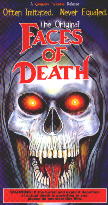 Instead, it suggests the statistical evidence linking media violence and aggressive behavior is similar in strength to the evidence linking smoking and lung cancer.
Instead, it suggests the statistical evidence linking media violence and aggressive behavior is similar in strength to the evidence linking smoking and lung cancer.
.
.
.
The surgeon general's office didn't conduct any studies of its own, citing instead a raft of previous research on the subject. Studies used in writing the report found, for example, that people who had frequently watched "Road Runner" cartoons or "Starsky and Hutch" as children in the 1970s were more likely to exhibit aggressive behavior 15 years later. Men who as boys had watched violence most frequently, that study found, had "pushed, grabbed or shoved their spouse" at twice the rate of other men and had been convicted of crimes at three times the rate of other men. Similar effects were found for women.
In another study cited by the authors, college students who played the violent video game "Marathon 2" generated 43% more aggressive responses in later tests than those who played a nonviolent game. And in another study, researchers found that young black men who watched a violent rap music video were more likely to endorse the use of violence in a hypothetical conflict situation than those who watched a nonviolent rap video.
And from the LA Times, 1/18/01:
Satcher's final report said "a substantial body of research now indicates that exposure to media violence increases children's physically and verbally aggressive behavior in the short term," and notes that a smaller body of studies has shown a "small but statistically significant impact on aggression over many years."
In an interview, Satcher noted that though media exposure appeared to have only a "low-level" long-term effect on youth violence compared with kids' access to guns and other factors, "it's still enough that it ought to alert us that we need to be concerned about this."
.
.
.
The United States "is well past the 'nothing works' era with respect to reducing and preventing youth violence," the report concludes. "Less than 10 years ago, many observers projected an inexorably rising tide of violence. The recent marked reductions . . . appear to belie those dire predictions."
Nevertheless, "violent behavior remains alarmingly high" and "Americans cannot afford to become complacent," said Surgeon General David Satcher. "This is no time to let down our guard on youth violence."
.
.
.
What [the report] found is that drugs, guns, gangs and precociousness are all contributors to youth violence but that other factors—family, school, peers—vary in importance as children move from infancy to early adulthood. The report also found that exposure to media violence can increase aggressive behavior among children in the short term, although evidence was lacking on its long-term effects.
As for the numbers, the report found that youth homicide, robbery and arrest rates in 1999 were actually lower than they were in 1983, largely because of a decrease in the use of firearms by young people since the peak years of the mid-1990s.
But arrest rates for aggravated assaults remain nearly 70% higher than in 1983, and "self-report" studies, which elicit confidential reports by youths themselves, indicate that the rates of violent offenses have not declined in the last few years.
Sgt. Chris Pascoe of the Michigan State Police commented on the decrease in crime rates on 6/14/01:
[I]f you look at "all" of the statistics, you will see that America's problems are far from over: police have more than tripled the prison population in the last decade (hiding the problem from public view), and the major causes of crime remain intact, with an ever growing juvenile population whose rate of violent crime remains above all previously recorded averages.
The many kinds of media influence
Consider the many ways in which the media influences people:
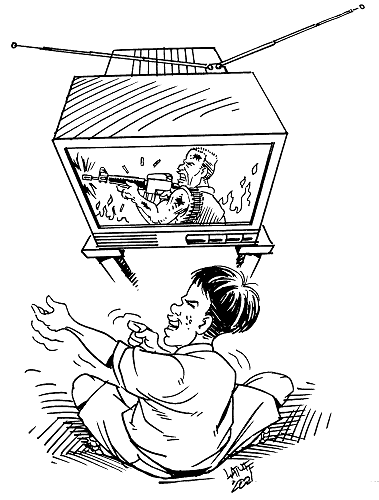
And more:
"99% of students in grades 7 through 12 can identify Anheuser-Busch's Budweiser as a brand of beer."
"Sexual references-per-hour of prime-time television were three times higher in 1999 than in 1989."
"[Radio] dialogue is frequently explicit and deliberately shocking."
Marilyn Manson concert promotes profanity, drugs, unhealthy sex, hate toward authority.
SchoolRumors.com: a typical media influence.
The Bible as media violence.
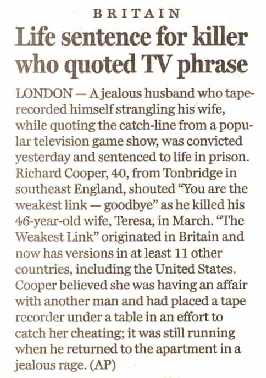
Terrorism and media violence
After the 9/11/01 attack on America, book publishers, video game makers, and other media companies forgot themselves and began curtailing the violence in their products. In response to the broadcasters who filtered their transmissions, I wrote the following letter to the LA Times, 9/19/01:
It's fascinating to see movie studios, TV networks, and radio stations eliminate any broadcasts that might hurt people's feelings or give criminals ideas. After the crisis is over, presumably, they'll resume filling the airwaves with prejudice, hate, violence, and death. That shouldn't be a problem because, as they keep reassuring us, media messages don't affect the real world.
For more on the subject, see Terrorists Followed Media Violence Script.
But even when media moguls "get it," they still don't get it:
Among those lyrics considered "questionable," according to Clear Channel's Jack Evans, are Frank Sinatra's "New York, New York," James Taylor's "Fire and Rain" and Ricky Nelson's "Travelin' Man." These songs are questionable, yet the homophobic, kill-a-cop tunes from the likes of Eminem and Snoop Dog are okay. Let's get our priorities straight here.
Toby Keeler, letter, LA Times, 9/22/01
That it took thousands of deaths to sensitize media companies to the harm their products may do is little short of reprehensible. What will it take for them to permanently curb their excesses—another Holocaust? Unbelievable.
The media's argument is that they're just responding to the marketplace. But the facts suggest that even that feeble excuse is wrong. From the LA Times, 10/24/01:
EDITORIAL
Cinema Gunplay: Drop Dead
Typically, when they're criticized for gun violence in movies and television, entertainment industry executives say they're only providing what people want to see. Oops, wait a sec. Those cinematic and broadcast decision makers might want to set their sights on a survey released this morning by an industry panel on violence.
The nationwide survey, sponsored by the nonprofit Entertainment Industries Council, covered 462 people, about half of them adults and half of them teenagers. The survey shows that gun violence in movies or TV is, brace yourself, the least attractive dramatic element. At 19%, gunplay comes in dead last, so to speak, on a long list of movie-TV attractions, below physical conflict (40%), sex/romance (55%), suspense (67%) and adventure (75%). Put that in your storyboard and write it.
In fact, gun violence would discourage the most people from viewing a program or movie (44%), compared with sex/romance (15%), suspense (9%) and adventure (7%). But, wait, there's another plot twist: The survey was actually done back in June, way before the events of Sept. 11 drilled home, live on TV, the awfulness of real violence and its sudden, life-snuffing consequences.
Like all of us, the entertainment industry was stunned by the terrorism. Some movie releases were postponed and other plans were shelved, at least for a time—with the unspoken expectation that Americans, with their Wild West and enduring gun culture, eventually would return to fascination with violence. Maybe. But entertainment by definition is escapist. Whether most Americans, youths included, still want to escape to explosions and murder after witnessing the real things remains to be seen.
Meanwhile, here's the survey's kicker: The element that gets the most people to watch a movie or program is—you're gonna laugh at this—humor (83%). Given the choice between watching someone drop with a sudden, gory hole in his body or watching a funny scene, four times as many people choose laughter. It's such a crazy idea it just might work!
For more on the subject, see Pop Culture: Time to Get Serious.
Not only do people say they want less violent entertainment, they put their money where their mouths are. From the Los Angeles Times, 4/14/02:
G is for Grosses
By LYNN SMITH
UC Irvine economics professor Arthur De Vany and UCI colleague W. David Walls will publish in July a study in the quarterly academic publication Journal of Business that shows G-rated films are less risky and have greater success rates than R-rated films even in theatrical runs. "The paradox is that people think Hollywood makes R-rated movies out of concern for the bottom line," De Vany said. In fact, he said, the truth is just the opposite: Hollywood could have increased its profits by producing more G-rated movies.
.
.
.
UCI's De Vany said that while studios often talk about market demographics and penetration, "they have no clue. You can't predict these things."
In the Journal of Business study, De Vany and Walls studied more than 2,000 films from 1984 to 1994 and found G-rated movies dominated other ratings categories in box office and video revenues. A separate analysis of films dating from 1994 to 2000 produced identical results.
"It's an industry where learning is difficult," De Vany said.
.
.
.
[A chart shows] the top 10 movies of all time at the box office (as of last Sunday), measured by their domestic gross in millions of dollars. Of the top 100, 22 are rated R, but you have to go all the way down to No. 25, 1984's "Beverly Hills Cop," to find the first of only four R-rated movies among the top 50.
Media violence continues
Despite the push against media violence, it continues unabated. From the LA Times:
TV violence is surging, group says
A media watchdog study of broadcast networks finds incidents have risen 75% since 1998.
By Jim Puzzanghera, Times Staff Writer
January 11, 2007
WASHINGTON — Violence on broadcast TV is approaching "epidemic proportions," surging 75% over the last six years while posing a threat to children that parents and government officials need to address, according to a major media watchdog study unveiled Wednesday.
The study by the Parents Television Council, titled "Dying to Entertain," said the 2005-06 season was the most violent since the group began tracking the issue in 1998. There were an average of 4.41 violent incidents each prime-time hour last season, based on the group's analysis of the first two weeks of the ratings sweeps periods.
Federal Communications Commission member Michael J. Copps, a longtime critic of TV violence, joined the group at a news conference Wednesday and warned broadcasters that the government might act if programming wasn't voluntarily toned down.
"People are concerned about this race to the bottom," he said. "They wonder if there even is a bottom. I do, too. If broadcasters do not step up to the plate and self-police, I don't think any of us should be surprised if Congress decides to step in."
Violence was defined broadly to include such scenes as car crashes and "gory autopsies." The Parents Television Council also said it counted in its total the bloody scenes and dead bodies aired on the increasing number of forensic and medical dramas, such as CBS' "CSI" franchise and ABC's "Grey's Anatomy," because they showed the consequences of violence.
Overall violent incidents increased in every time slot and across all broadcast networks, according to the study. Violence jumped by 45% from 8 to 9 p.m., by 92% from 9 to 10 p.m. and by 167% from 10 to 11 p.m.
The FCC has been studying the issue for more than two years after pressure from Congress. Copps said he expected a report to be released soon. But Congress so far has shown no inclination to give the FCC authority to fine broadcasters for graphic or gratuitous violence the way it can for indecency.
A bill to grant that power failed to gain traction after it was introduced in 2005. But the bill's sponsor, Sen. John D. Rockefeller IV (D-W. Va.), now has more clout with Democrats in the majority in Congress. He plans to reintroduce the legislation and hopes that it will get a hearing in the next few months, said his spokeswoman, Wendy Morigi.
Broadcasters have noted there are more violent programs on cable TV and stress the use of blocking technology, such as the V-chip. Broadcasters and cable firms are in the midst of a $300-million campaign to educate parents about the technology.
"We're surprised that cable TV programming was not included in the PTC study, since broadcast TV is far less violent than 'Sopranos-like' programming found on cable," the National Assn. of Broadcasters said in a written statement. "NAB believes the best approach is to arm responsible parents with the tools needed to screen out shows that may be inappropriate for children, as opposed to censoring some of the most popular programming on television."
Parents Television Council President Timothy Winter said the V-chip was not the solution, calling TV ratings inconsistent.
But data he cited about rating inaccuracies were from a study done in 1998 by the Kaiser Family Foundation. The Parents Television Council study did not determine whether the shows it found with violent incidents had correct ratings, said Melissa Caldwell, the group's senior director of programs.
The study builds on a similar 2003 report from the Parents Television Council. The new data come from an analysis of entertainment programs on the broadcast networks during the first two weeks of the November, February and May sweeps over the last three seasons.
During the 2005-06 season, guns were the weapon of choice, featured in 63% of violent scenes, the study found. A majority of violent scenes — 54% — featured either a death or an implied death. Increasingly, violence has become more central to plotlines and includes sexual elements, Winter said.
ABC showed the sharpest increase in the study, with violent incidents each prime-time hour more than tripling from an average of 0.93 in 1998 to 3.8 in the 2005-06 season. ABC officials said in a statement that they had not seen the report but were "confident that our extensive standards review of all of our programming insures acceptable content for our diverse viewing audiences."
ABC, however, had the lowest score among the four major broadcast networks last season. NBC topped the group with an average of 6.79 violent incidents per prime-time hour, followed by CBS at 5.56 and Fox at 3.84. The WB network had 3.52 violent incidents per hour and UPN had the best score at 0.86. WB was combined with UPN this year to form the CW network.
Winter urged action at all levels to prevent the negative psychological effect that studies had shown violent programming could have on children. He called on producers to cut down on the violence, network affiliates to refuse to air shows that were too graphic, advertisers to stay away from such programs and parents to be more aware of what their children were watching.
"We're not calling for a ban on anything," he said. "We're calling for some responsibility and restraint from the broadcasters."
Conclusion
Returning to our original correspondent, I say:
Study the record, friend. See how the media affects society as a whole, not just people like you in their happy cocoons. The evidence supports my position overwhelmingly.
Rob
More media-violence resources
Media coverage of Grossman's killology research
Related links
Highlights of the FTC report on media violence
Why parents aren't fully responsible for how their kids turn out
Violence in America
America's cultural mindset
Readers respond
"[M]y gut reaction is to believe my experiences rather than a study that, as quoted, is vague on causality."
"Parents, school, and peers shape children from their earliest days, not films" (Oliver Stone 1995).
"There is one problem with this issue; the human mind doesn't operate under the influence of movie and music violence."
"I am writing a paper on how I believe that cartoon violence DOES not affect kids."
"Simply awesome! My sincere congratulations on a GREAT job."
"Surgeon General to Rob Schmidt: You are wrong!"
"Does media cause violence, or are violent people drawn to violent media?"
|
. . . |

|
All material © copyright its original owners, except where noted.
Original text and pictures © copyright 2007 by Robert Schmidt.
Copyrighted material is posted under the Fair Use provision of the Copyright Act,
which allows copying for nonprofit educational uses including criticism and commentary.
Comments sent to the publisher become the property of Blue Corn Comics
and may be used in other postings without permission.